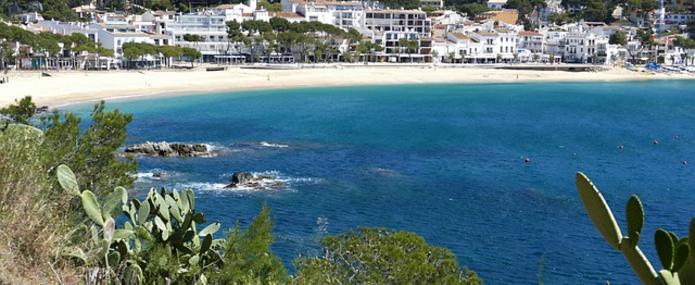Climate change will intensify slow-onset and rapid-onset coastal risks worldwide, with impacts on housing, infrastructure, ecosystems and economic activities. Spain and France are facing these impacts on their coasts and launching new initiatives to prepare and adapt to climate risks, taking a long-term perspective. How do these reforms address drivers of vulnerability and what is needed to overcome the challenges for implementation?
Vulnerability, risks, impacts: a dynamic & inclusive approach is needed
Recent weather events remind us of the vulnerability of coastal zones to storm surge and flooding. Gradual changes (e.g. erosion and sea level rise) are also affecting these landscapes. While coastal risks are often associated with Small Island Developing States (SIDS), or developing countries (particularly in large deltas, such as in Bangladesh and Vietnam), developed countries are not immune (OECD, 2019).1 In Europe, storms Gloria in Spain (January 2020) and Dennis in France (February 2020) caused beach loss (up to 32 meters near Valencia), cliff erosion (Brittany coast), intrusion of salt water in rice farms (Ebro delta) and the disruption of electricity in up to 20,000 homes in regions of France (Brittany, Loire, and Normandy).
As a result, coastal risks have made their way up the political agenda. Both countries do indeed have long coastlines—France (5,500 km) and Spain (7,800 km); and adaptation strategies, which involve a mix of engineering structures (sea walls, levees), nature-based solutions (restoring salt marshes) and other options (‘managed retreat’ or relocation, i.e. moving communities and assets back to a safer location inland). Preventing risks by restricting development is also part of these strategies, through Coastal Laws, which however struggle to take into account the dynamic nature of the shoreline and to coordinate relevant stakeholders. Coastal ecosystems are naturally resilient and subject to change, where sandy beaches, dunes or coastal vegetation can act as a natural buffer against flooding, but they are also vulnerable to depletion form extreme events or human interventions, whether intentional or not. For example, sea walls provide protection for a section of the coastline but can block sediment movement, thus hampering natural accretion and erosion processes and stress ecosystems nearby, such as wetlands. As a result, adaptation strategies need to take a holistic approach along sediment cells and account for progressive modifications.
While plans in Spain and France use coastal vulnerability assessments including the identification of sensitive areas, they have to be revised regularly due to changes in the environment.
In addition, Coastal Laws struggle to coordinate relevant stakeholders. Even when plans are dynamic, implementing them reveal the complexity of managing a patchwork of ownership structures with often conflicting interests between inhabitants, municipalities, developers and businesses. Managed retreat or relocation decisions, for instance, are particularly complex as they challenge private property rights. Nevertheless, continuing development in vulnerable areas and investing large amounts in engineering structures, or financing recovery and reconstruction after disasters (a business-as-usual trajectory) risks maladaptation and lock-in to unsustainable protection strategies. Therefore, long-term adaptation relies on governance arrangements to coordinate actors, build consensus and balance economic development with the protection of the environment. For example, promoting engagement through consultations helps to mobilise competences and expertise across public and private actors that have interests along the coast and if complemented by capacity-building can help ensure that these actors have the available tools and resources to understand the effects of climate change and plan in the medium to long-term (Losada et al., 2019).2
The challenge of revising coastal laws
The national adaptation plans in Spain (PNACC, 2006) and in France (PNACC-2, 2018) highlight the vulnerability of coastal zones. The Spanish PNACC calls for the integration of adaptation into laws, in particular the Coastal Law (Law 22/1988), which was reformed into the Protection and Sustainable Use of the Coastline (Law 2/2013). Along with mainstreaming environmental protection, the law sets the criteria of the public domain and restricts private development (up to 100 meters from the shoreline and extendable to 200 meters, through a local authority decision). Similarly, the Loi Littoral (1986) in France restricts development to at least 100 meters from the shoreline.
Despite legal tools dating back to the 1980’s, these coastal laws are facing critical turning points because development pressures and climate change impacts have led to increased vulnerability.
Following the impacts of storm Gloria in January, the Spanish Ministry for Ecological Transition announced plans to revise the national Coastal Law. In the past, reforms were carried out to address growing urbanisation. However legal uncertainties around the rights of ownership between public and private entities in a changeable environment triggered tensions, especially when private houses fell in the public domain due to beach loss overtime where the High Water Mark moved inland (López-Gutiérrez et al., 2016).3 Certain coastal protection activities such as building dams have disrupted natural processes with effects on wetlands. To address this range of issues, revisions aim to reinforce ecosystems, especially wetlands and dunes, with nature-based initiatives to make these systems more resilient in the face of climate change (Escolar & Rejón, 2020).4 Planned reforms will reinforce the protection of reserves and national parks including the implementation of a National Wetland Plan in 2021. In short, the coastal law revision will place the emphasis on the conservation of coastal zones and reinforcing natural processes.
Similar to the experiences of Spain, the French coastline has been an attractive space for development, in particular for secondary residences since the 1960’s. Rising climate risks on coastal areas are having major impacts, where sea level rise, marine flooding and erosion is expected to put at risk 5,000-50,000 houses by the end of the century in addition to ports and a few large cities (Madelenat, 2019).5 In reaction to these concerns, at the fourth meeting of the Conseil de défense écologique in February, the Ministry for Ecological Transition called for new risk reduction measures along the coast. This includes, in the short term, the prohibition of new constructions in areas at risk to erosion, and in the long term the creation of a new building permits for these areas at risk that will allow only non-perennial plants and removable constructions (Boughriet, 2020).6 Public awareness and transparency of information to buyers on exposure about the receding coast will also play a role in these new initiatives.
Towards a forward-looking approach
These reforms in Spain and France intend to reinforce sustainable practices along the coast to set the path for long-term adaptation. Learning from past trends can help to identify drivers of vulnerability, path dependencies that create lock-ins and limit maladaptation. Adaptation pathways consist in a forward-looking approach that allows sequencing possible adaptation actions across medium- to long-time horizons (Magnan & Duvat, 2016).7 Different climate futures will have different impacts and adaptation pathways allow to plan a range of actions while providing flexibility. Among options, reforms will face the challenge of opening up pathways for expropriation (buyout programs) to prepare for retreat and relocation policies in areas that are increasingly exposed to coastal risks. For example, in France, two action plans were implemented focusing on relocation (2012-2015) and on integrated coastal management (2017-2019) after storm Xynthia in 2010 caused extensive damage along the western Atlantic. More recently, the Senate has articulated how to take these action plans a step forward, in particular looking at the role of legal tools, such as the Coastal Law surrounding coastal retreat and expropriation.
While coastal zones are highly vulnerable to climate change, they are also contentious areas because they present opportunities for development (seaside homes), tourism and economic activities (fisheries, oyster, rice farming). Plans to revise regulatory mechanisms on urban planning and reinforce the protection of ecosystems should be co-designed through a dialogue across stakeholders. Public authorities will have an important role in this process by communicating vulnerability assessments and facilitating partnerships to encourage risk informed development and to mobilise investments in different adaptation actions. The effectiveness of initiatives will depend on coordination across stakeholders and more specifically the formulation of acceptability (of adaptation options and risk levels), where governance arrangements will play a key role in fostering long-term adaptation.
Image from Pixabay
- 1OECD. (2019). Responding to Rising Seas: OECD Country Approaches to Tackling Coastal Risks. https://doi.org/https://doi.org/10.1787/9789264312487-en
- 2Losada, I. J., Toimil, A., Muñoz, A., Garcia-Fletcher, A. P., & Diaz-Simal, P. (2019). A planning strategy for the adaptation of coastal areas to climate change: The Spanish case. OceanandCoastalManagement, 182(1). https://doi.org/https://doi.org/10.1016/j.ocecoaman.2019.104983
- 3López-Gutiérrez, J., Negro, V., & Dolores Esteban, M. (2016). New Coastal Regulation in Spain. A roadmap to a better approach to coastal environment. Journal of Coastal Research, 75(1), 662–666. https://doi.org/https://doi.org/10.2112/SI75-132.1
- 4Escolar, I., & Rejón, R. (2020, February 27). Teresa Ribera: “Modificaremos la ley de costas porque hay mucho desorden en el litoral.” Eldiario.Es. https://www.eldiario.es/sociedad/Teresa-ribera_0_1000200190.html
- 5Madelenat, J. (2019). L’adaptation au changement climatique sur le littoral français. https://www.lafabriqueecologique.fr/app/uploads/2019/07/Etude-Littoral.pdf
- 6Boughriet, R. (2020, February 12). Le Gouvernement accentue la lutte contre les inondations et l’érosion côtière. ActuEnvironnement.Com. https://www.actu-environnement.com/ae/news/conseil-defense-ecologique-inondations-erosions-cotieres-34969.php4
- 7Magnan, A., & Duvat, V. K. E. (2016). Vulnerability pathways and adaptation to climate change in Reunion Island. https://www.iddri.org/en/publications-and-events/policy-brief/vulnerability-pathways-and-adaptation-climate-change-reunion




